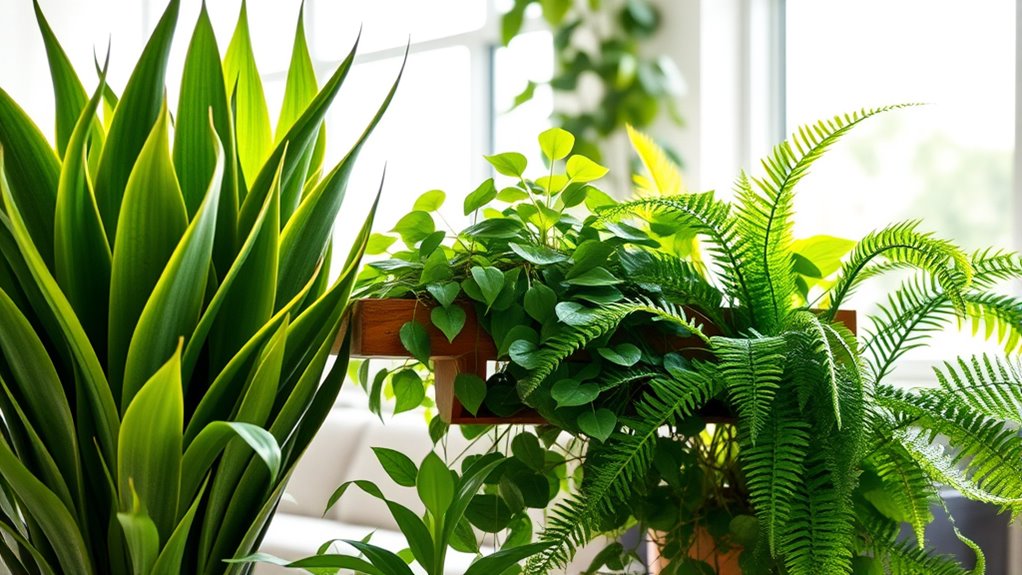If you want to purify indoor air naturally, several plants can help, like the Peace Lily, Snake Plant, Spider Plant, and Boston Fern. These plants absorb pollutants such as formaldehyde, benzene, and xylene through their leaves and roots, cleaning your environment without chemicals. They also boost oxygen levels and reduce allergens. To get the best benefit, learn how to care for and place these plants properly—you’ll find more useful tips ahead.
Key Takeaways
- Plants like Peace Lily, Snake Plant, and Boston Fern effectively remove VOCs such as formaldehyde, benzene, and xylene from indoor air.
- English ivy reduces mold particles and absorbs toxins like formaldehyde and benzene, improving air quality.
- Plants absorb airborne pollutants through leaves and roots, metabolizing or storing toxins to naturally purify indoor environments.
- Indoor plants support air purification with minimal maintenance, but their effectiveness is limited without proper placement and additional filtration.
- Besides air cleaning, indoor plants enhance mental well-being by reducing stress and fostering a calming, natural atmosphere.
Top Plants for Removing Formaldehyde and Benzene
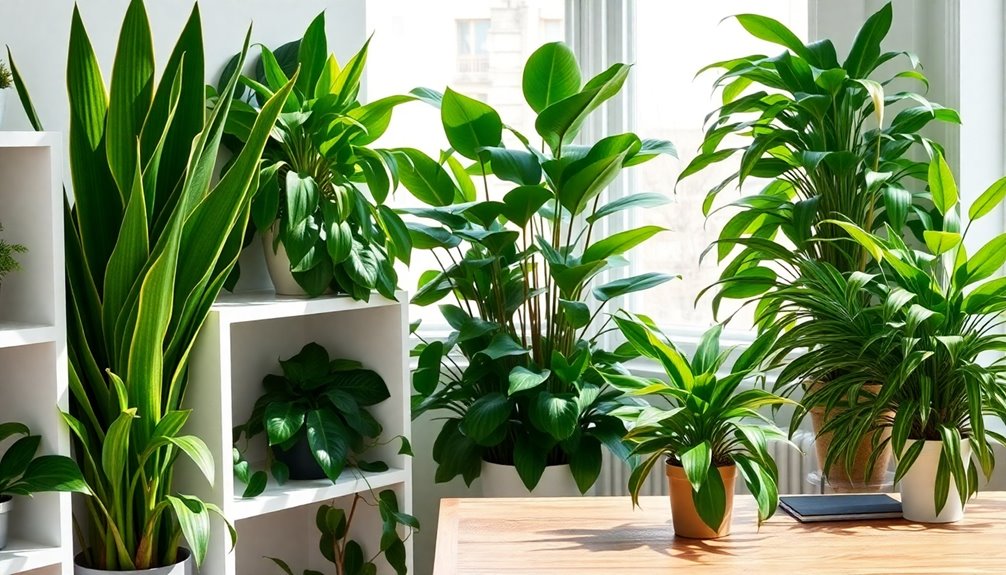
Are you looking for indoor plants that can actively improve your air quality? If so, certain plants excel at removing formaldehyde and benzene from your home. The Peace Lily is a top choice, thanks to its ability to eliminate multiple pollutants like benzene, trichloroethylene, xylene, and ammonia. Aloe Vera is another excellent option; it not only reduces formaldehyde but also benzene, all while requiring minimal maintenance. Boston Ferns effectively remove formaldehyde and xylene and thrive in humid environments. The Philodendron domesticum has shown promise in small experiments for formaldehyde removal, and Dracaena is often listed among effective formaldehyde eliminators. These plants interact with pollutants through their leaves and roots, helping to purify your indoor air naturally. Additionally, some plants are known for their air-purifying capabilities, making them valuable additions to any indoor space. Scientific studies confirm that indoor plants can absorb and break down harmful airborne toxins, further supporting their role in creating healthier indoor environments. Incorporating natural air filters like these plants can significantly enhance your home’s air quality and create a healthier living environment.
How Snake Plant and Spider Plant Enhance Air Quality
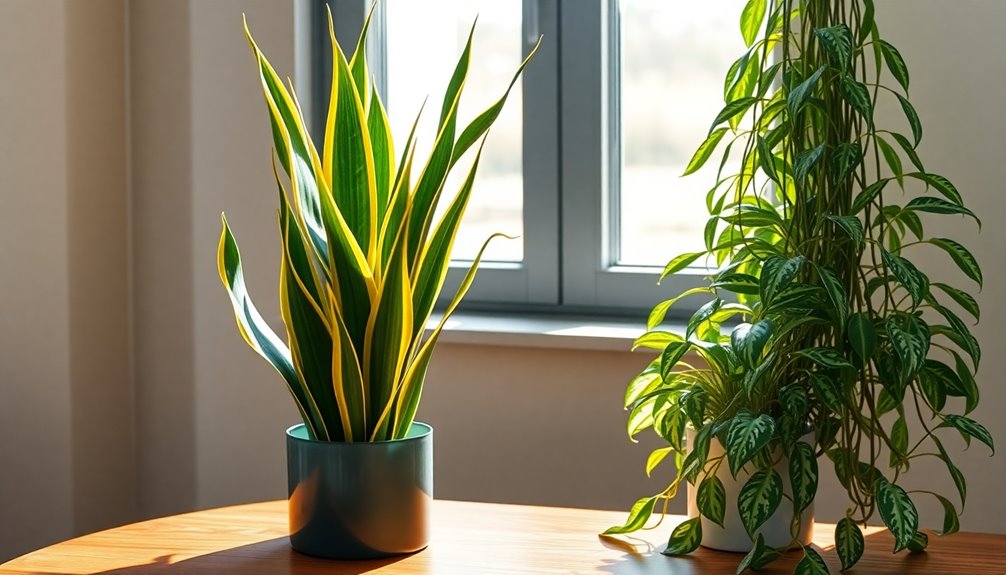
Both the Snake Plant and Spider Plant stand out as effective natural air purifiers that can markedly boost your indoor air quality. The Snake Plant removes up to four major toxins like formaldehyde, benzene, and xylene, while also producing oxygen at night, helping you breathe easier during sleep. It releases moisture that reduces airborne allergens such as dust and pet dander, improving overall air hygiene. The Spider Plant efficiently eliminates pollutants like formaldehyde, benzene, and carbon monoxide, increasing indoor humidity and decreasing allergens. Both plants absorb toxins through their leaves, continuously cleaning the air. They thrive indoors with minimal care, making them practical choices for ongoing air purification. Additionally, their ability to improve indoor air quality supports healthier living environments. Incorporating these plants into your space can also help enhance home decor with their attractive foliage. Their natural capacity to filter airborne toxins makes them excellent choices for maintaining a cleaner, healthier indoor environment. Together, they create a healthier environment by reducing harmful substances and enhancing oxygen levels indoors.
Peace Lily and Bamboo Palm: Natural Air Cleaners
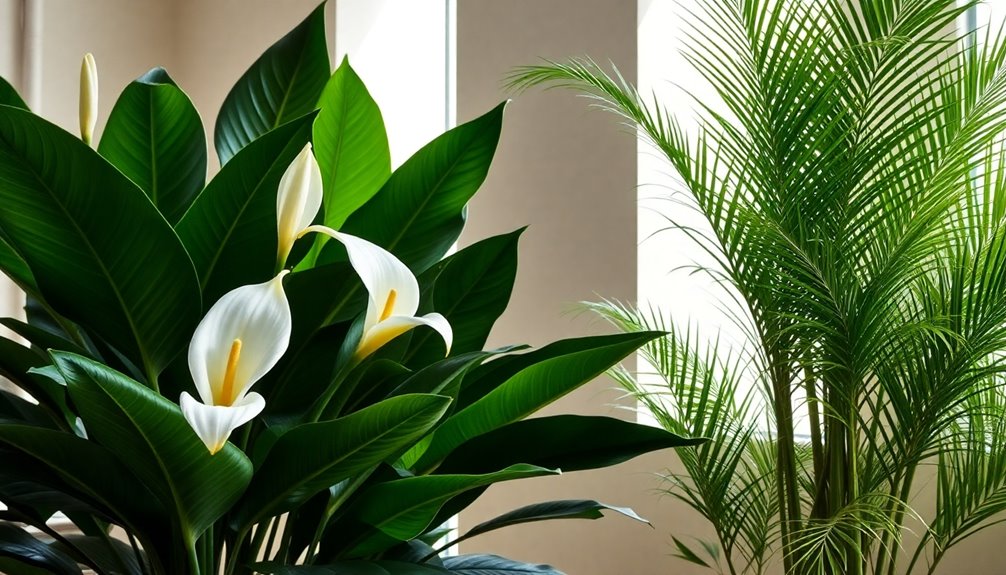
In your indoor environment, incorporating Peace Lily and Bamboo Palm can considerably improve air quality by naturally filtering out common pollutants. Peace Lilies are especially effective at removing trichloroethylene (TCE), benzene, formaldehyde, and ammonia, improving air quality by up to 60%. They also capture dust, pollen, and mold spores, helping reduce allergy symptoms. Peace Lilies thrive in bright, indirect light and prefer damp soil, making them easy to care for. Additionally, their ability to remove indoor toxins makes them a valuable natural air purifier. Bamboo Palms excel at removing volatile organic compounds (VOCs) and boost oxygen levels, contributing to a healthier space. They tolerate low to bright indirect light and require consistent moisture. AI-powered tools are increasingly being used to analyze and optimize indoor air quality, making it easier to maintain healthy environments. Understanding indoor air pollution can help you select the best plants for your space. Together, these plants target different pollutants, enhancing your indoor air quality while adding a calming, natural aesthetic to your home.
The Role of Ivy in Reducing Mold and VOCs
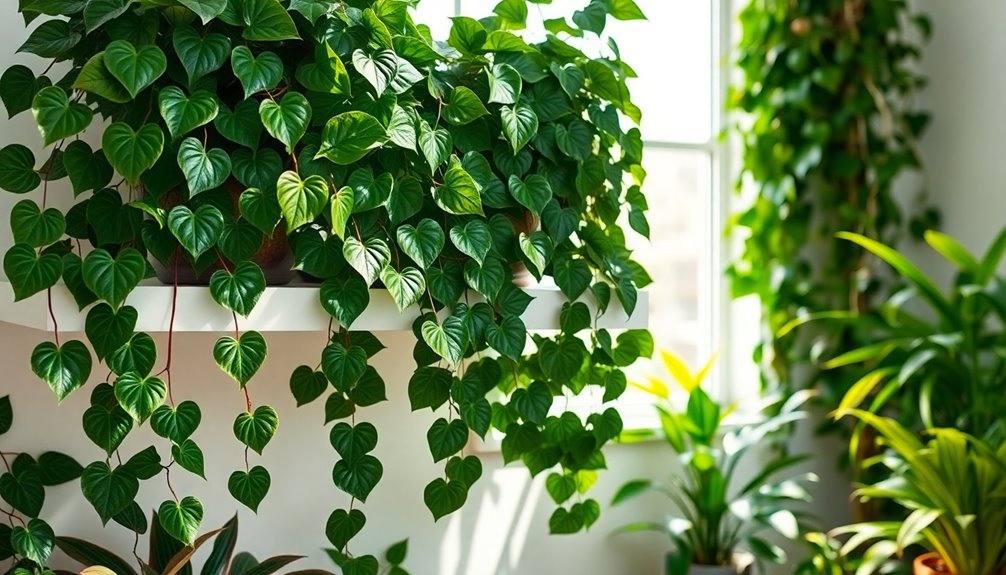
Have you ever wondered how certain houseplants can improve indoor air quality? English ivy is a powerful natural air purifier. It can markedly cut airborne mold particles, reducing them by 60% in six hours, and remove about 58% of fecal matter particles within the same time. Ivy effectively reduces VOCs like formaldehyde, benzene, and trichloroethylene—known carcinogens—by absorbing and metabolizing them through its leaves and roots. Its broad leaves trap mold spores and airborne pollutants, while microorganisms in the root zone help break down these toxins into inert substances. This process not only lowers mold spore levels but also helps improve respiratory health, reduce allergy symptoms, and decrease susceptibility to infections. Scientific research underscores that plant-based air purification contributes significantly to healthier indoor spaces. Additionally, supporting indoor environmental quality through proper plant care can enhance the effectiveness of air purification. Ivy’s natural filtering makes it a valuable addition to any mold-prone or chemically sensitive indoor space.
Understanding How Plants Absorb and Break Down Pollutants
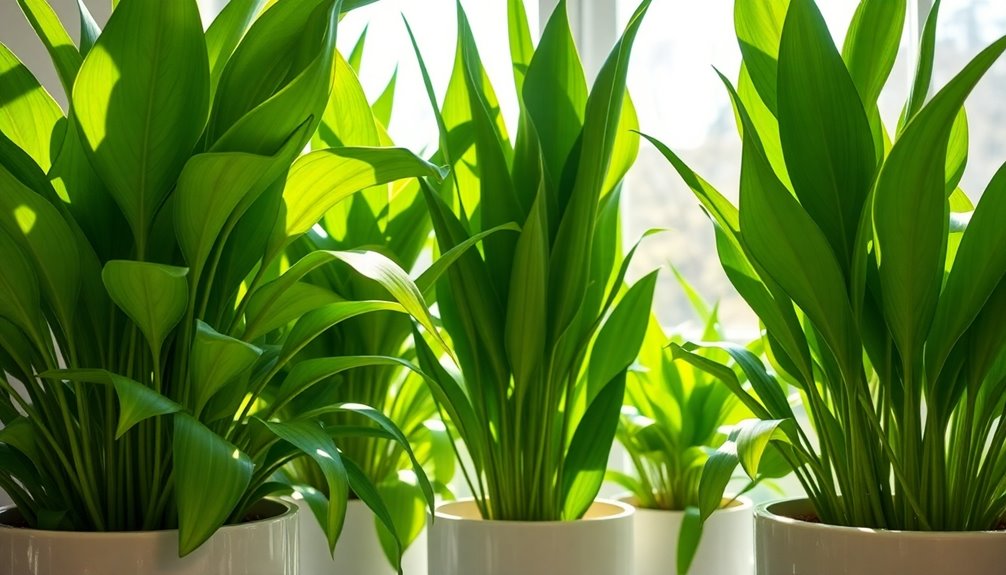
Plants absorb airborne pollutants through their leaves and roots, actively removing harmful substances from indoor air. During photosynthesis, they take in carbon dioxide, converting it into oxygen and glucose, which boosts indoor oxygen levels. This process supports plant health, enabling better pollutant absorption. Through transpiration, water vapor is released via stomata, creating airflow that pulls in pollutants like VOCs, nitrogen oxides, and particulate matter. Once pollutants enter the plant tissues, they may be metabolized or stored in less harmful forms, reducing toxicity. Some plants can concentrate toxins in their tissues, acting as hyperaccumulators. However, in typical indoor environments, the effectiveness of plants alone is limited because ventilation dilutes pollutants faster than plants can absorb them. Still, plants contribute to air purification by physically trapping and breaking down airborne contaminants. Additionally, certain plant species are particularly effective at pollutant removal, making them especially beneficial for improving indoor air quality.
Practical Tips for Maintaining Effective Indoor Greenery
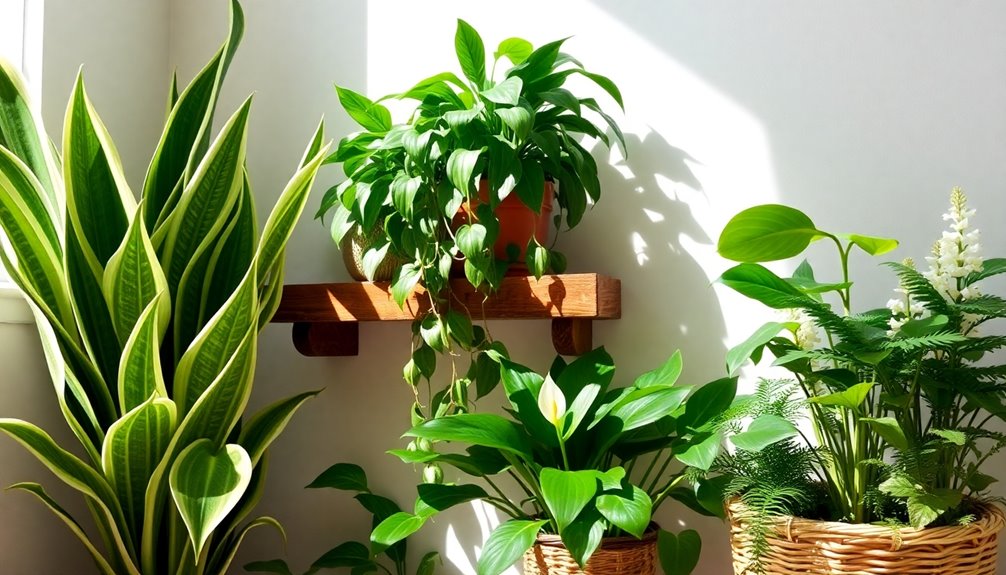
Maintaining healthy indoor greenery requires consistent and mindful care routines. Water your plants every 1-2 weeks, checking soil dryness 2 inches below the surface to avoid overwatering. Use filtered or distilled water to prevent mineral buildup, and consider self-watering pots or wicking systems for extended absences. Group plants with similar hydration needs, like snake plants with ZZ plants, to simplify watering. Position low-light tolerant varieties in shaded areas and rotate plants weekly for even light exposure. Supplement natural light with full-spectrum LED grow lights in darker spaces. Repot every 12-18 months in well-draining soil, trimming circling roots to promote growth. Regularly wipe leaves to remove dust, and apply diluted fertilizer monthly during growth seasons. Consistent care routines are essential for keeping your indoor plants healthy and effective at purifying air. Additionally, paying attention to the lighting conditions ensures your plants receive the appropriate amount of light for optimal health and air purification. Incorporating crochet styles for locs can also serve as a creative way to personalize your plant care accessories or plant hangers, blending your passions seamlessly. Understanding the importance of plant selection can help optimize air purification and aesthetic appeal in your space, especially when choosing species known for their air-purifying properties.
Limitations of Plant-Based Air Purification in Homes
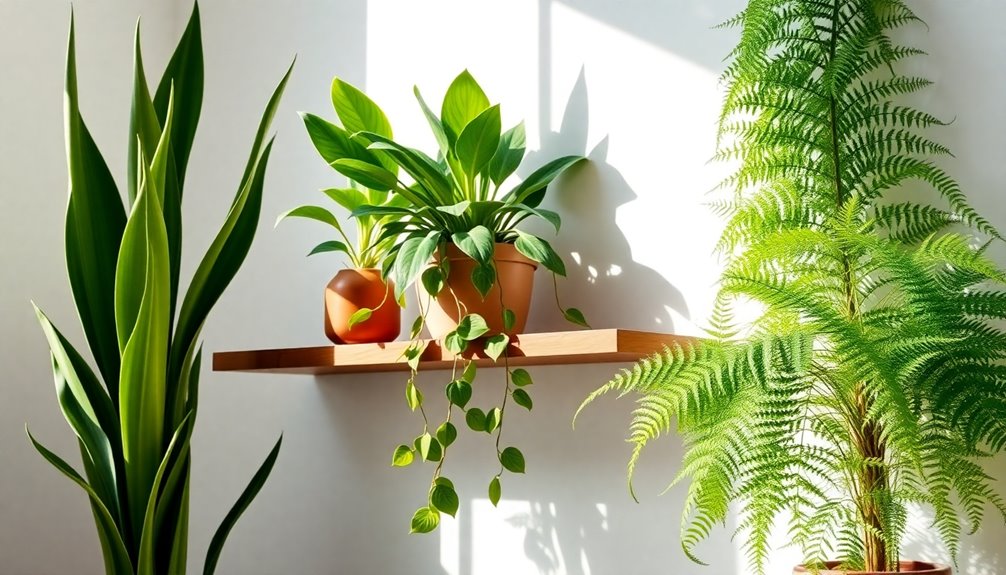
While indoor plants can contribute to improving air quality, their overall effectiveness in removing pollutants is limited in typical home environments. Most research supporting their air-purifying abilities was done in sealed chambers, which don’t reflect real homes. Larger spaces and multiple VOCs reduce plants’ ability to clean the air effectively. Achieving noticeable purification often requires many plants, which isn’t practical for most households. Plants mainly target certain VOCs but do little against particulates or microbes. Their ability to remove pollutants varies by species, and some plants may even emit VOCs from soil or pots, potentially harming indoor air. Maintenance is essential; neglect can lead to mold and microbial growth, worsening air quality. Overall, plants alone can’t replace mechanical purifiers for thorough indoor air cleaning. Additionally, indoor plant selection plays a critical role in determining their effectiveness, as not all species are equally capable of purifying air. Proper placement and plant care are also vital to prevent unintended negative effects.
Additional Benefits of Indoor Plants for Well-Being
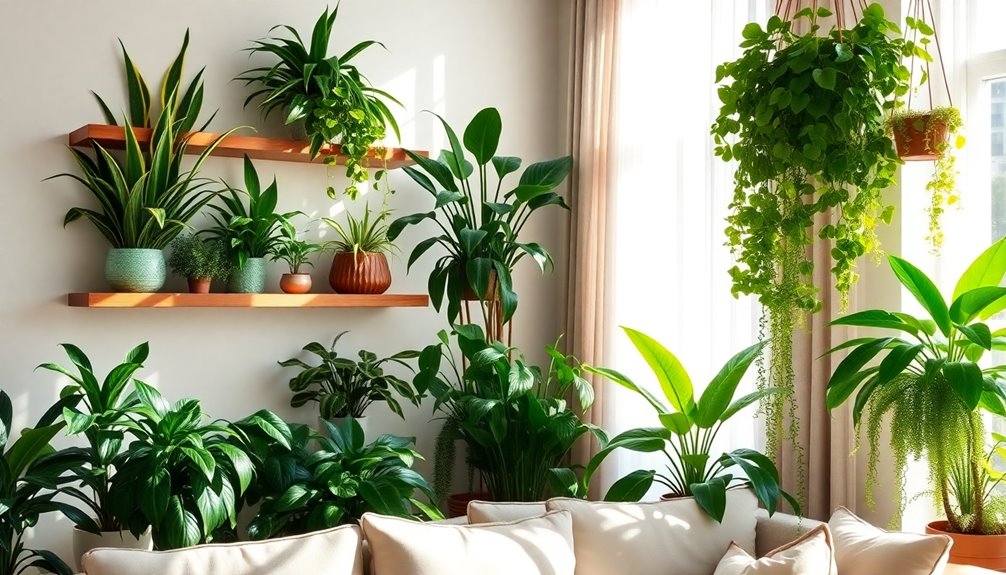
Indoor plants offer more than aesthetic appeal; they actively boost your well-being by improving mood, reducing stress, and fostering a sense of connection to nature. Interacting with plants lowers anxiety and depressive symptoms while decreasing cortisol and blood pressure. Their presence creates a comforting environment that promotes relaxation and belonging. Caring for plants provides therapeutic benefits, helping you manage stress and calm your nervous system. Additionally, indoor greenery sharpens your focus and enhances cognitive function, supporting better attention and mental recovery. Plants also contribute to physical health by reducing blood pressure and cortisol levels, and they can improve respiratory health indirectly. Overall, incorporating indoor plants transforms your space into a sanctuary of mental clarity, emotional resilience, and physical wellness.
Frequently Asked Questions
How Many Plants Are Needed to Significantly Improve Indoor Air Quality?
You wonder how many plants you need to considerably improve indoor air quality. Unfortunately, the number is quite high—potentially 10 to 1,000 plants per square meter. While plants like spider and snake plants help, they don’t drastically clean the air alone. To truly see a difference, you’ll need large-scale installations like green walls or combine plants with air purifiers and proper ventilation for effective results.
Can Indoor Plants Remove All Types of Indoor Air Pollutants Effectively?
You might wonder if indoor plants can remove all indoor air pollutants effectively. While they can absorb some VOCs like formaldehyde, their impact is limited in typical spaces. You’d need an impractical number of plants for significant cleaning, especially for gaseous pollutants like carbon monoxide. For exhaustive air purification, combining plants with mechanical purifiers is your best bet, as plants alone can’t handle all types of pollutants efficiently.
Are There Any Health Risks Associated With Keeping Indoor Plants?
Well, in the days of yore, folks kept plants indoors for beauty and health. Today, you should know there are some risks. You might trigger allergies from mold or plant allergens, and overwatering can cause mold growth, worsening air quality. Toxic plants pose poisoning risks, especially for pets or kids. To stay safe, clean your plants regularly, identify toxic varieties, and keep them out of reach.
How Often Should Indoor Plants Be Cleaned for Optimal Air Purification?
You should clean your indoor plants every 1-2 weeks to keep them functioning at their best. Gently wipe the leaves with a damp cloth or rinse them under lukewarm water, avoiding harsh chemicals. Regular cleaning removes dust and grime that block leaf pores, ensuring peak VOC absorption. Also, check the soil for buildup or overwatering issues. Consistent cleaning helps your plants continue improving your indoor air quality effectively.
Do Indoor Plants Help Reduce Indoor Airborne Mold and Bacteria?
Think of indoor air as a bustling city, filled with invisible villains like mold spores and bacteria lurking in shadows. You can turn your space into a cleaner sanctuary by adding plants that act as natural guardians. They absorb airborne toxins, regulate humidity, and create microclimates that hinder mold growth. But remember, for full protection, pair plants with proper ventilation and air purifiers—they’re a team effort in air defense.
Conclusion
Bringing indoor plants into your space is like adding a gust of fresh air to your life—they naturally filter out toxins and boost your well-being. While they’re wonderful allies, remember they’re just part of a healthy environment, not a complete solution. Keep your plants thriving with proper care, and you’ll enjoy cleaner air and a more vibrant home. Just like a garden needs tending, your indoor air quality benefits from your attention and love.
